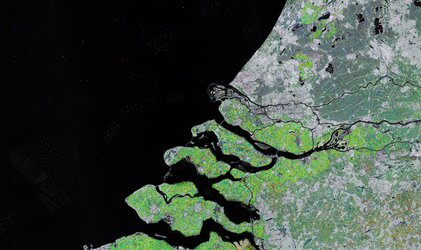Accept all cookies Accept only essential cookies See our Cookie Notice

About ESA
The European Space Agency (ESA) is Europe’s gateway to space. Its mission is to shape the development of Europe’s space capability and ensure that investment in space continues to deliver benefits to the citizens of Europe and the world.
Highlights
ESA - United space in Europe
This is ESA ESA facts Member States & Cooperating States Funding Director General Top management For Member State Delegations European vision European Space Policy ESA & EU Space Councils Responsibility & Sustainability Annual Report Calendar of meetings Corporate newsEstablishments & sites
ESA Headquarters ESA ESTEC ESA ESOC ESA ESRIN ESA EAC ESA ESAC Europe's Spaceport ESA ESEC ESA ECSAT Brussels Office Washington OfficeWorking with ESA
Business with ESA ESA Commercialisation Gateway Law at ESA Careers Cyber resilience at ESA IT at ESA Newsroom Partnerships Merchandising Licence Education Open Space Innovation Platform Integrity and Reporting Administrative Tribunal Health and SafetyMore about ESA
History ESA Historical Archives Exhibitions Publications Art & Culture ESA Merchandise Kids Diversity ESA Brand Centre ESA ChampionsLatest
Space in Member States
Find out more about space activities in our 23 Member States, and understand how ESA works together with their national agencies, institutions and organisations.
Science & Exploration
Exploring our Solar System and unlocking the secrets of the Universe
Go to topicAstronauts
Missions
Juice Euclid Webb Solar Orbiter BepiColombo Gaia ExoMars Cheops Exoplanet missions More missionsActivities
International Space Station Orion service module Gateway Concordia Caves & Pangaea BenefitsLatest
Space Safety
Protecting life and infrastructure on Earth and in orbit
Go to topicAsteroids
Asteroids and Planetary Defence Asteroid danger explained Flyeye telescope: asteroid detection Hera mission: asteroid deflection Near-Earth Object Coordination CentreSpace junk
About space debris Space debris by the numbers Space Environment Report In space refuelling, refurbishing and removingSafety from space
Clean Space ecodesign Zero Debris Technologies Space for Earth Supporting Sustainable DevelopmentLatest
Applications
Using space to benefit citizens and meet future challenges on Earth
Go to topicObserving the Earth
Observing the Earth Future EO Copernicus Meteorology Space for our climate Satellite missionsCommercialisation
ESA Commercialisation Gateway Open Space Innovation Platform Business Incubation ESA Space SolutionsLatest
Enabling & Support
Making space accessible and developing the technologies for the future
Go to topicBuilding missions
Space Engineering and Technology Test centre Laboratories Concurrent Design Facility Preparing for the future Shaping the Future Discovery and Preparation Advanced Concepts TeamSpace transportation
Space Transportation Ariane Vega Space Rider Future space transportation Boost! Europe's Spaceport Launches from Europe's Spaceport from 2012Latest

Dutch mosaic
Thank you for liking
You have already liked this page, you can only like it once!
This image is a mosaic based on Sentinel-1A satellite coverage of the Netherlands in three scans during March 2015.
The Netherlands borders the North Sea to the north and west, Germany to the east, and Belgium to the south.
Home to some 17 million inhabitants, the country is extremely low-lying and remarkably flat, with large stretches of lakes, rivers and canals. With over 400 people per sq km, it is one of the most densely populated countries in the world.
The North Sea is regarded as a threat to the country and people. Following the huge flood of 1953, the whole area has been built up with dikes and protective dams, which are clearly visible in the image.
If the country were to lose the protection of its dunes and dikes, the most densely populated part of the Netherlands would be inundated, mainly by the sea but also partly by the rivers.
Also clearly visible in the image are the typical, narrow and long green fields between Utrecht and Rotterdam, scattered with canals and smaller villages.
The artificial island of Flevoland, which has been reclaimed from the Zuiderzee, an inland sea, is also visible.
We are also able to see the offshore wind farms built to support a green economy, using renewable energy that is readily available in the Netherlands due to a very high incidence of windy days.
On the bottom left corner is a river delta formed by the confluence of the Rhine, the Meuse and the Scheldt rivers, resulting in a multitude of islands. Rotterdam, Europe’s largest harbour, is visible at the northern edge, with ships waiting to enter the port in the North Sea.
Sentinel-1A has been in orbit since April 2014, monitoring the marine environment and mapping water and soil surfaces, among other major applications.
This image is featured on the Earth from Space video programme.
-
CREDIT
Copernicus Sentinel data (2015)/ESA -
LICENCE
ESA Standard Licence and Additional permission may be required
(contact spaceinimages@esa.int for further information)

Earth from Space: Dutch mosaic

Flevoland, the Netherlands

The Netherlands

Earth from Space: Southwest Netherlands















 Germany
Germany
 Austria
Austria
 Belgium
Belgium
 Denmark
Denmark
 Spain
Spain
 Estonia
Estonia
 Finland
Finland
 France
France
 Greece
Greece
 Hungary
Hungary
 Ireland
Ireland
 Italy
Italy
 Luxembourg
Luxembourg
 Norway
Norway
 The Netherlands
The Netherlands
 Poland
Poland
 Portugal
Portugal
 Czechia
Czechia
 Romania
Romania
 United Kingdom
United Kingdom
 Slovenia
Slovenia
 Sweden
Sweden
 Switzerland
Switzerland
























